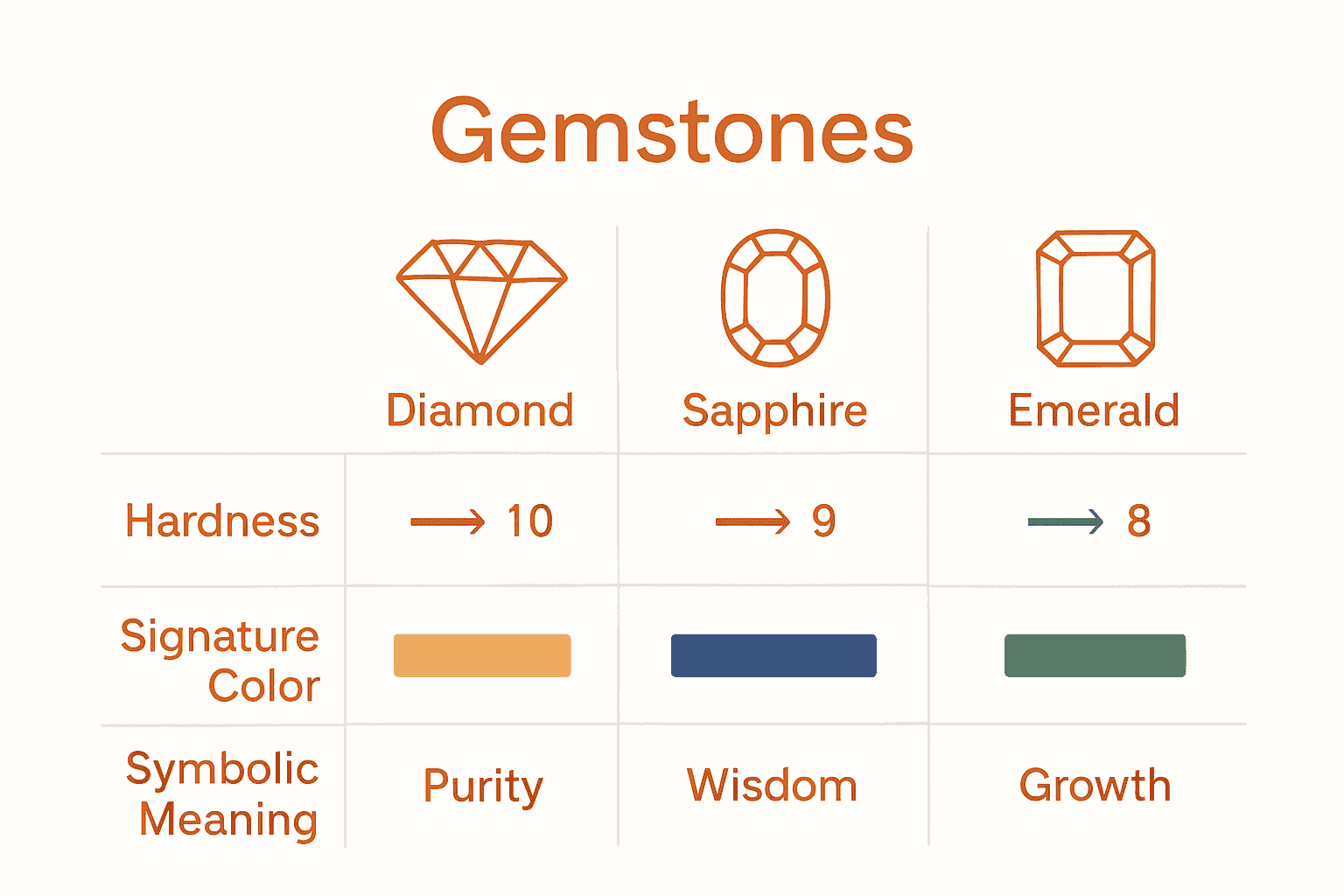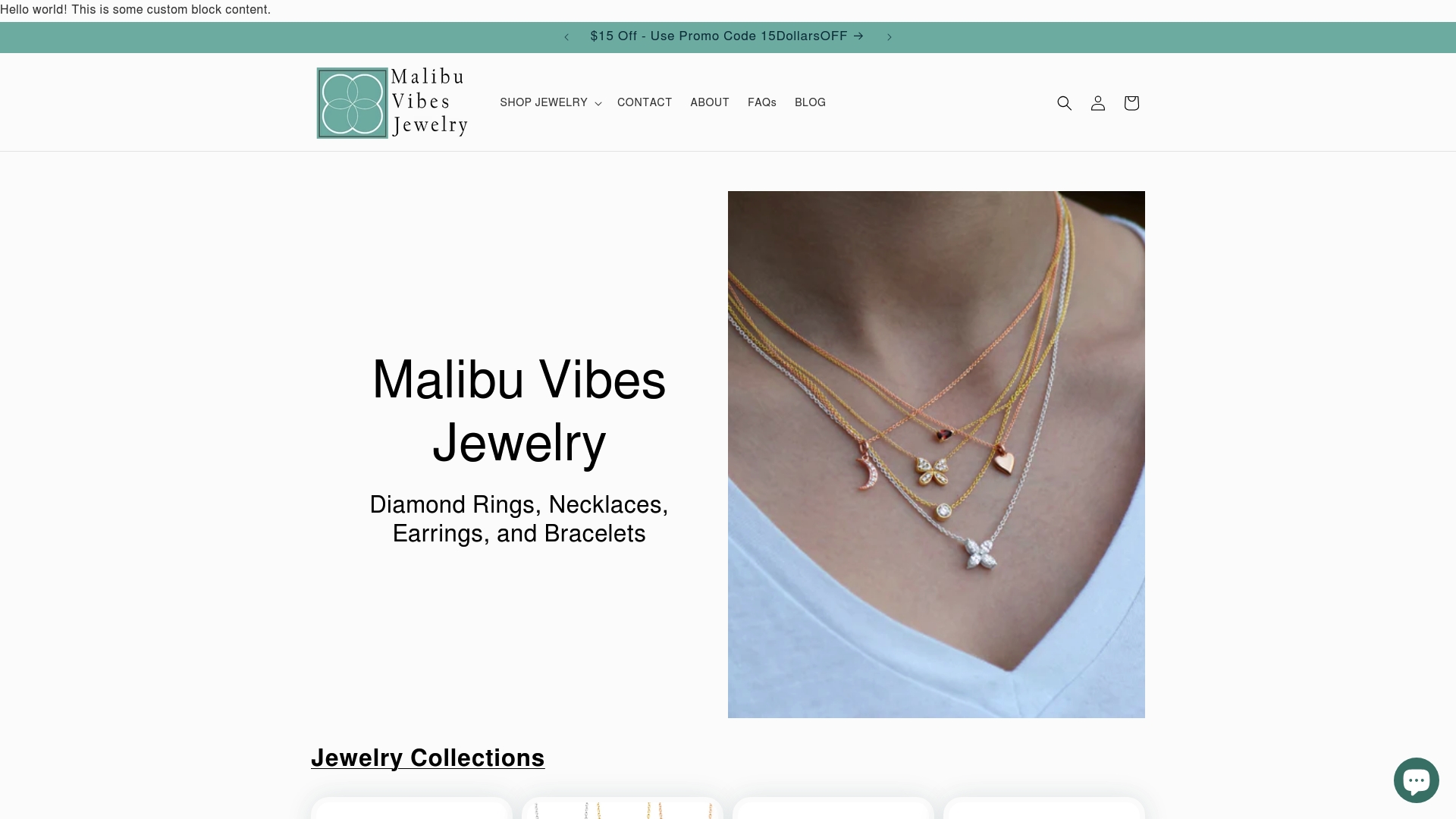Over 2,000 natural minerals have been discovered, but fewer than 100 are prized as gemstones. These rare treasures have captivated people for centuries, turning simple jewelry into lasting symbols of beauty, power, and emotion. From the glimmer of a diamond to the deep green of an emerald, gemstones shape the stories we tell through jewelry and the expression of personal style.
Table of Contents
- Defining The Role Of Gemstones In Jewelry
- Major Types Of Gemstones Used Today
- Selecting Gemstones For Fine Jewelry Pieces
- Symbolism And Cultural Significance Of Gemstones
- Quality, Value, And Care Considerations
Key Takeaways
| Point | Details |
|---|---|
| Role of Gemstones | Gemstones symbolize beauty, status, and personal expression, serving as cultural artifacts that transcend mere decoration. |
| Major Types | Only about 100 out of 2,700 known minerals are utilized as gemstones, with diamonds, sapphires, and rubies being particularly significant in jewelry. |
| Selecting Gemstones | Choosing the right gemstone involves evaluating color intensity, clarity, cut, and emotional resonance to ensure personal connection and aesthetic appeal. |
| Quality and Care | Exceptional gemstones require careful consideration of quality factors such as color purity and clarity, along with proper maintenance to preserve their beauty. |
Defining the Role of Gemstones in Jewelry
Gemstones have been extraordinary human companions throughout history, transforming from simple decorative objects into powerful symbols of beauty, status, and personal expression. According to Britannica, the fundamental essence of a gemstone lies in its ability to captivate through beauty, which encompasses color, transparency, and an enchanting inner “fire”.
Historically, gemstones have represented far more than mere aesthetic adornments. USGS research reveals that societies worldwide have treasured these precious minerals, with early jewelry incorporating stones like amber, amethyst, coral, diamond, emerald, and turquoise. Their significance transcends decoration - they are cultural artifacts that communicate meaning, status, and personal narrative.
The role of gemstones in jewelry can be understood through several key dimensions:
- Aesthetic Appeal: Creating visual beauty and capturing light
- Personal Expression: Communicating individual style and personality
- Cultural Significance: Representing traditions, beliefs, and social status
- Emotional Connection: Serving as meaningful gifts and personal talismans
Beyond their visual allure, gemstones must possess remarkable durability. Britannica emphasizes that a true gemstone must withstand constant handling while maintaining its polish and structural integrity. This resilience ensures that jewelry pieces become not just temporary accessories, but potential heirlooms passed through generations.
Modern jewelry enthusiasts appreciate gemstones for their complex interplay of scientific marvel and artistic expression. From the precise geological conditions required for their formation to the skilled craftsmanship needed to transform rough stones into polished gems, these minerals represent a fascinating intersection of natural wonder and human creativity.
Discover more about selecting meaningful gemstones in our guide to choosing intentional jewelry.
Major Types of Gemstones Used Today
The world of gemstones is a vibrant tapestry of color, rarity, and geological marvel. According to Britannica, out of over 2,000 identified natural minerals, fewer than 100 are actually used as gemstones, with only 16 achieving significant importance in the jewelry and collector markets.
EBSCO research highlights the most prominent gemstone varieties that dominate the market:
- Diamonds: The pinnacle of brilliance and durability
- Sapphires and Rubies: Corundum family stones known for intense colors
- Emeralds: Beryl variety prized for rich green hues
- Quartz: Including popular amethyst subspecies
- Topaz: Ranging from colorless to vibrant blue
- Tourmaline: Offering incredible color diversity
- Spinel: Often mistaken for rubies
These gemstones are not just visually stunning but represent complex geological formations. Britannica notes a comprehensive list of significant gemstones including beryl, chrysoberyl, corundum, diamond, feldspar, garnet, jade, lazurite, olivine, opal, quartz, spinel, topaz, tourmaline, turquoise, and zircon.
Here’s a comparison of the major gemstone types and their defining features:
| Gemstone Type | Key Characteristics | Signature Color(s) | Symbolic Meaning |
|---|---|---|---|
| Diamond | Exceptional hardness High brilliance |
Colorless Rare colored varieties |
Love Strength |
| Sapphire | High durability Corundum mineral |
Blue Pink Yellow |
Wisdom Loyalty |
| Ruby | Vibrant color Corundum mineral |
Deep red | Passion Courage |
| Emerald | Beryl family Distinct inclusions |
Rich green | Rebirth Fertility |
| Amethyst (Quartz) | Transparent Varied purity |
Purple | Clarity Calmness |
| Topaz | Good clarity Wide color range |
Colorless Blue Yellow |
Affection Success |
| Tourmaline | Broad color spectrum | Pink Green Black |
Creativity Protection |
| Spinel | Often used as ruby substitute | Red Pink Blue |
Inspiration Renewal |
Understanding the nuanced characteristics of each gemstone type requires appreciating their unique properties.
 Factors like color intensity, clarity, cut, and rarity determine a gemstone’s value and desirability. Professional jewelers and gemologists spend years mastering the intricate details that make each stone extraordinary.
Factors like color intensity, clarity, cut, and rarity determine a gemstone’s value and desirability. Professional jewelers and gemologists spend years mastering the intricate details that make each stone extraordinary.

For those interested in exploring the fascinating world of gemstone cuts that showcase these beautiful minerals, check out our guide to essential gemstone cuts.
Selecting Gemstones for Fine Jewelry Pieces
Choosing the perfect gemstone for fine jewelry is an art form that balances scientific understanding with aesthetic appreciation. USGS defines a true gemstone as a material possessing three critical attributes: beauty, rarity, and durability. Out of approximately 2,700 mineral species, only about 100 meet these exacting standards.
The selection process involves careful evaluation of several key factors:
- Color Intensity: Depth and purity of the stone’s hue
- Clarity: Presence or absence of internal imperfections
- Cut: How the stone is shaped to maximize light reflection
- Carat Weight: Measuring the stone’s physical size and value
Preparing gemstones for jewelry requires exceptional craftsmanship. Britannica reveals that most minerals must be carefully cut and polished, with diamonds presenting unique challenges due to their extraordinary hardness. Jewelers typically employ three primary cutting techniques: tumbling, cabochon cutting, and faceting.
Beyond technical considerations, selecting a gemstone is also an emotional journey. Each stone tells a story - reflecting personal style, commemorating special moments, or expressing individual taste.
Professional gemologists spend years developing the expertise to guide customers toward stones that not only look beautiful but resonate on a deeper, more personal level.
For those looking to dive deeper into the nuanced world of gemstone selection, our guide to choosing gemstones offers comprehensive insights into making the perfect choice.
Symbolism and Cultural Significance of Gemstones
Gemstones have transcended mere decorative objects throughout human history, embodying profound cultural and spiritual significance across civilizations. Britannica reveals that ancient cultures viewed gems as more than aesthetic accessories, often attributing mysterious powers and miraculous qualities to different stones.
Historically, gemstones carried deep symbolic meanings:
- Protection: Stones believed to ward off evil spirits
- Strength: Gems like diamonds symbolizing courage in battle
- Spiritual Connection: Representing divine or mystical energies
- Social Status: Demonstrating wealth and social positioning
Fascinating historical examples abound. For instance, Britannica notes that diamonds were thought to provide warriors strength in battle and protect against ghosts and magical influences. Different civilizations imbued specific stones with unique attributes, creating a rich tapestry of cultural interpretations.
Today, the relationship with gemstones has evolved. USGS observes that contemporary appreciation centers more on aesthetic pleasure and personal beauty rather than supernatural beliefs. Modern jewelry wearers choose stones that resonate with their personal style, emotional connections, and individual aesthetic preferences.
For those intrigued by the deeper meanings behind gemstone colors and their cultural significance, explore our guide to understanding birthstone colors.
Quality, Value, and Care Considerations
Understanding the quality and value of gemstones requires a nuanced approach that goes beyond simple visual assessment. USGS emphasizes that truly exceptional gemstones represent a rare intersection of beauty, rarity, and durability, with only about 100 mineral species out of 2,700 meeting these stringent criteria.
Key factors determining a gemstone’s quality include:
- Color Purity: Intensity and consistency of hue
- Clarity: Absence of internal imperfections
- Cut Precision: How effectively the stone reflects light
- Carat Weight: Physical size and mass
- Origin: Geographical source and geological conditions
Britannica reveals fascinating insights into gemstone enhancement techniques. Some stones undergo sophisticated treatments like controlled heating, X-ray exposure, or strategic pigment application to improve their visual characteristics. These methods require expert knowledge to distinguish between natural and enhanced stones.
Proper care is crucial for maintaining a gemstone’s longevity and brilliance. Different stones require unique maintenance approaches, ranging from gentle cleaning to careful storage. Professional jewelers recommend periodic professional inspections to assess structural integrity and prevent potential damage.
For jewelry enthusiasts seeking deeper insights into preserving their precious pieces, our guide to understanding fine jewelry craftsmanship offers comprehensive care recommendations.
Elevate Your Style with Meaningful Gemstone Jewelry
Choosing the perfect gemstone is about more than just appearance. This article highlights how gemstones embody beauty, durability, and personal expression, but many shoppers struggle with finding pieces that truly reflect their unique story. If you want to wear jewelry that captures your individuality while offering lasting quality, understanding gemstone characteristics is key.
Discover our carefully curated collection of 14k Color Gemstone Rings crafted to celebrate the unique qualities of each stone.

Experience timeless craftsmanship with Malibu Vibes Jewelry where luxury meets personal meaning. Start your journey today by exploring our stunning 14k Gold Color Gemstone Necklace collection and find the perfect symbol for your style. Visit Malibu Vibes Jewelry now to secure a piece that will become part of your story.
Frequently Asked Questions
What are the primary roles of gemstones in jewelry?
Gemstones serve multiple roles in jewelry, including aesthetic appeal, personal expression, cultural significance, and emotional connection, making them powerful symbols of beauty and status.
How do I choose the right gemstone for fine jewelry pieces?
Selecting the right gemstone involves evaluating color intensity, clarity, cut, and carat weight, along with considering personal style and emotional significance.
What factors determine the quality and value of a gemstone?
The quality and value of a gemstone are determined by factors such as color purity, clarity, cut precision, carat weight, and origin, with only about 100 mineral species meeting stringent gemstone standards.
What are the most common types of gemstones used today?
Commonly used gemstones include diamonds, sapphires, rubies, emeralds, quartz, topaz, tourmaline, and spinel, each with unique characteristics and symbolic meanings.
Recommended
- The Meaning of Different Gemstones – A Guide to Choosing Intentional J – Malibu Vibes Jewelry
- 7 Essential Types of Gemstone Cuts Every Jewelry Lover Should Know – Malibu Vibes Jewelry
- 7 Essential Types of Gemstone Cuts Every Jewelry Lover Should Know – Malibu Vibes Jewelry
- 7 Essential Types of Gemstone Cuts Every Jewelry Lover Should Know – Malibu Vibes Jewelry



